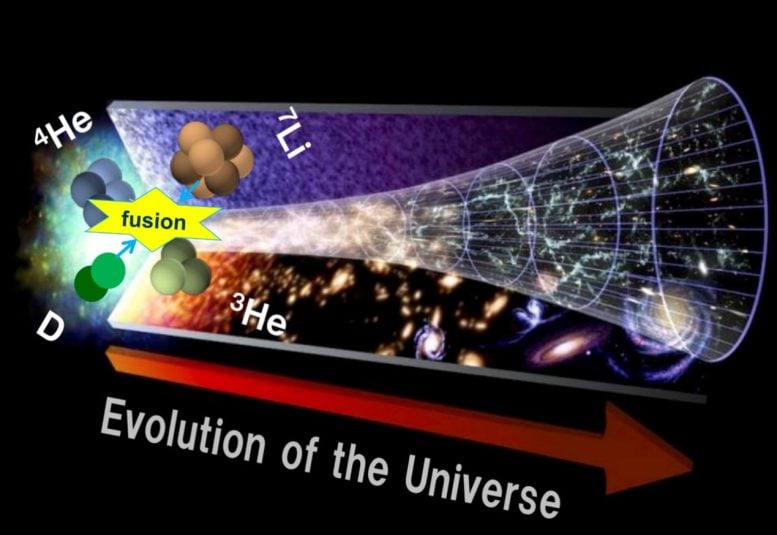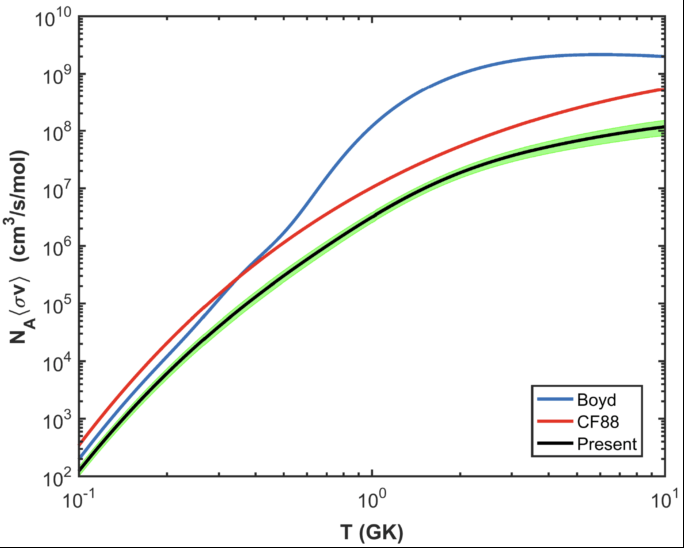Understanding the Big Bang and the Cosmological Lithium Problem

Figure 1. Artist’s representation of the evolution of the universe, with time flowing to the right in the direction of the red arrow. The 7Li(d,n)24He reaction takes place in the process of primordial nucleosynthesis at the very beginning. Credit: Modified version of NASA’s image by HOU Suqing
Recently, an international research team successfully updated the 7Li(d,n)24He reaction rate based on the latest experimental data, which removes the significant ambiguity in the cosmological lithium (Li) problem from the perspective of nuclear physics.
The Big Bang is currently regarded as the most successful model to describe the origination and evolution of the universe. However, its success has been limited by the so-called lithium problem, which refers to the fact that primordial lithium-7 abundance is overpredicted by a factor of three in comparison to the value from observation, while predictions match the observed primordial deuterium and helium abundances.
From the perspective of nuclear physics, the accurate reaction rates of lithium destruction reactions are very crucial for accurate prediction of the primordial lithium-7 abundance and further understanding of the lithium problem. Nevertheless, as an important lithium-7 destruction reaction, the 7Li(d,n)24He reaction has not been well studied before 2018.
A new study published in The Astrophysical Journal updated the 7Li(d,n)24He reaction rate based on the recent experimental measurements on the three near-threshold beryllium-9 excited states. This work was conducted by an international research team, which was led by HOU Suqing at the Institute of Modern Physics (IMP), Chinese Academy of Sciences (CAS).

Figure 2. Total reaction rate of 7Li(d,n)24He as a function of temperature in units of giga Kelvin where the green shaded band is its associated uncertainties. For comparison, researchers also plot the previous results from CF88 and BM93. Credit: Image by HOU Suqing
Researchers found that the new 7Li(d,n)24He rate is overall smaller than the previous estimation by about a factor of 60 at the typical temperature of the onset of primordial nucleosynthesis.
In addition, researchers presented uncertainties of the 7Li(d,n)24He reaction rate that are directly constrained by experiments for the first time.
According to the study, the new results remove the significant ambiguity in the calculated lithium-7 abundance due to this reaction, which will be useful to understand the primordial lithium problem and probe exotic physics beyond the standard model.
Reference: “New Thermonuclear Rate of 7Li(d,n)24He Relevant to the Cosmological Lithium Problem” by S. Q. Hou, T. Kajino, T. C. L. Trueman, M. Pignatari, Y. D. Luo and C. A. Bertulani, 25 October 2021, The Astrophysical Journal.
DOI: 10.3847/1538-4357/ac1a11
This work was supported by the Strategic Priority Research Program of CAS, the Youth Innovation Promotion Association of CAS and the National Natural Science Foundation of China.
Other institutions involved in the study include University of Tokyo (Japan), National Astronomical Observatory of Japan (Japan), Beihang University (China), the University of Hull (UK), Hungarian Academy of Sciences (Hungary), Michigan State University (US), and Texas A&M University- Commerce (US).
No comments:
Post a Comment